Jodie Dalgleish – 15 November, 2009
Clegg documents the experience of walking the city, bringing to mind the art of the dérive (drift) practiced in Paris between late 1950 and early 1970 by proponents of the Situationist International (SI), such as Guy Debord.
New Plymouth-based artist David Clegg’s latest project, Rerecordings 2006-2009, has resulted in an exhibition that is an important part of the Dunedin Public Art Gallery’s Summer season, Foreign Exchange, which also includes the touring Tom Kreisler and Miguel Angel Rios.
With the late Argentinian-born and New Plymouth-based artist and friend Tom Kreisler in mind, Clegg brings together photographs and recordings made in Santiago, Chile in 2006 with those made in Dunedin in 2009. There are seven series or ‘Results’, each presenting an indexed line of paired black and white photographs taken in either Chile or Dunedin, and a CD player and headphones with which a visitor can listen to a series of related soundbites. Each pair of photographs ‘bookend’ a particular sited moment with the top photograph of each pair marking the beginning of its related soundbite, and the bottom, the end.
Clegg also presents two cabinets that contain photographs from what were the current Santiago and Dunedin newspapers, along with transistor radios playing concurrent news broadcasts from either country. By relating all of these similar but differently located and culturally inflected moments in this way, he creates a space of “uncanny equivalence” in which signals may cross; a space that seems both ‘here or there’ and ‘here and there’. Time makes and is common to each moment, and yet it is independent of location.
As with previous projects, such as The Imaginary Museum (2002-2004) and archivedestruct (2005-2006), Clegg engages in a process of making strange any idea of a familiar environment. He allows us to see and hear everyday aspects of a city as ‘new’ and intriguing, as if we are encountering them for the first time. Clegg presents snippets of locations he has walked through (or travelled in) while making his visual and audio record: paved park or city square spaces (Result 5); foodcourt or market spaces (Result 9); the city from bus windows (Result 13); plaza or mall-like spaces (Result 3) the city street (Result 12); the city from a cafe window (Result 8); mall-like thoroughfares (Result 6). His black and white photographs are often shot at unusual angles; they are snapped in passing, made oddly artful by their chance effects. In addition, his soundbites allow us to aurally unravel the daily hum of each city. They focus our ability to hear a passing footfall, car, truck or bus, a snatch of conversation and music.
Clegg documents the experience of walking the city, bringing to mind the art of the dérive (drift) practiced in Paris between late 1950 and early 1970 by proponents of the Situationist International (SI), such as Guy Debord. According to him, it involved the pleasure and absurdity of walking/wandering as a ‘calculated action determined by the absence of a proper locus’, and allowed ‘drifters’ to recreate the city for themselves. Although not postulating any SI theory whereby such an experience is a direct act of revolution in response to modernisation, Clegg seems concerned with allowing us to determine our own experience of a city within the quality of particular moments.
Though more overt and subversive in archivedestruct, Clegg also engages in a process that promises, yet never quite delivers, order or coherent continuity in the differently located moments he has collected and created. Each pair of photographs is introduced by an index card that details the location, date and time period related to its photograph and audio track. Within each series, moments occur in similar places, or at similar times of the day (mostly). And we almost find patterns in the way moments are related. Locations alternate in some way, and date and time (sometimes even sound) often seem to move forward. But there are always exceptions, acts of doubling back that seem to also follow some kind of logic. Clegg also creates gaps in three series by providing index cards but no photographs, or, in one case no index card or photographs. While highlighting the absurd and unfulfilled logic of the archive and ‘museumisation’ in general, he also brings to mind what the artist-collector Walter Grasskamp has curiously described as the most free kind of collector concerned with self-evident connections.
Perhaps most notable, and more obvious in Rerecordings than in previous projects, is the particular kind of spatial temporality created by the way Clegg treats and relates sight and sound. Visual images and audio tracks work together while also remaining separate in the eye, ear and mind of the viewer. They are definite in their sensorial reality. Photograph and soundbite become ‘objects’ of experience. They make space and time for singular and individual moments of experience, within and across cultures.
Above: From Result 9: Santiago, Dunedin. Immediately below: From Result 12: Santiago, Dunedin. Images and installation shots courtesy of the artist and DPAG.
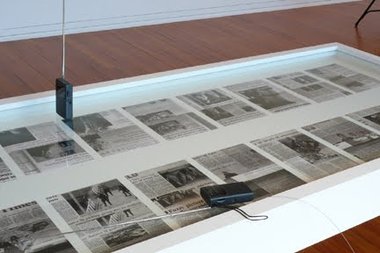

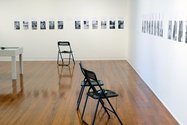
 Two Rooms presents a program of residencies and projects
Two Rooms presents a program of residencies and projects Advertising in this column
Advertising in this column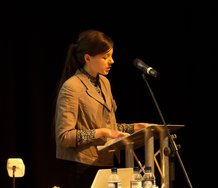
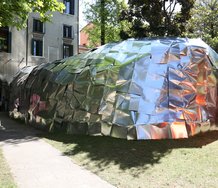
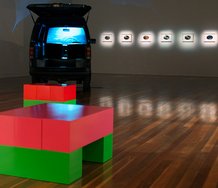
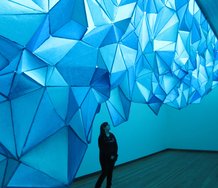
This Discussion has 0 comments.
Comment
Participate
Register to Participate.
Sign in
Sign in to an existing account.